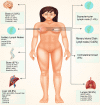Breast cancer: molecular mechanisms of underlying resistance and therapeutic approaches
- PMID: 35968356
- PMCID: PMC9360230
Breast cancer: molecular mechanisms of underlying resistance and therapeutic approaches
Abstract
Breast cancer (BC) affects over 250,000 women in the US each year. Drug-resistant cancer cells are responsible for most breast cancer fatalities. Scientists are developing novel chemotherapeutic drugs and targeted therapy combinations to overcome cancer cell resistance. Combining drugs can reduce the chances of a tumor developing resistance to treatment. Clinical research has shown that combination chemotherapy enhances or improves survival, depending on the patient's response to treatment. Combination therapy is a highly successful supplemental cancer treatment. This review sheds light on intrinsic resistance to BC drugs and the importance of combination therapy for BC treatment. In addition to recurrence and metastasis of BC, the article discussed biomarkers for BC.
Keywords: Breast cancer; breast cancer biomarkers; breast cancer metastasis; breast cancer recurrence; combination therapies; intrinsic/acquired resistance.
AJCR Copyright © 2022.
Conflict of interest statement
None.
Figures




References
-
- Siegel RL, Miller KD, Jemal A. Cancer statistics, 2020. CA Cancer J Clin. 2020;70:7–30. - PubMed
-
- Narod SA, Iqbal J, Miller AB. Why have breast cancer mortality rates declined? J Cancer. 2015;5:8–17.
-
- Althuis MD, Dozier JM, Anderson WF, Devesa SS, Brinton LA. Global trends in breast cancer incidence and mortality 1973-1997. Int J Epidemiol. 2005;34:405–412. - PubMed
-
- Britt KL, Cuzick J, Phillips KA. Key steps for effective breast cancer prevention. Nat Rev Cancer. 2020;20:417–436. - PubMed
-
- Glass AG, Hoover RN. Rising incidence of breast cancer: relationship to stage and receptor status. J Natl Cancer Inst. 1990;82:693–696. - PubMed
Publication types
LinkOut - more resources
Full Text Sources
